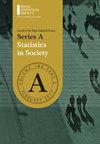流行病学研究中使用的暴露不确定性传播模型的比较
IF 1.5
3区 数学
Q2 SOCIAL SCIENCES, MATHEMATICAL METHODS
Journal of the Royal Statistical Society Series A-Statistics in Society
Pub Date : 2023-03-31
DOI:10.1093/jrsssa/qnad034
引用次数: 0
摘要
在生态流行病学研究领域,准确估计空气污染对健康的长期影响至关重要。为此,经常使用涉及接触评估和健康影响估计的两步模型。然而,暴露评估的准确性是不确定的,可能不能准确反映真实暴露。尽管提出了几种方法来管理这种不确定性,但不同方法对空气污染推论的影响仍然不确定。在本研究中,我们进行了一项模拟研究,比较了各种暴露不确定性传播模型对空气污染影响的推断,同时调查了它们对健康的影响。结果表明,无不确定性模型和多集方法优于先验方法和污染-健康联合模型(无截止)。此外,一项案例研究进一步强化了死亡率与PM2.5浓度之间联系的证据,表明PM2.5浓度每增加1 μg⋅m−3,苏格兰的全因死亡率可能增加4.51%[95%可信区间(CI), 3.42%, 5.49%]至7.51% (95% CI, 6.28%, 8.80%)。这些发现对寻求减轻空气污染有害影响的政策制定者和公共卫生官员具有重要意义。本文章由计算机程序翻译,如有差异,请以英文原文为准。
A comparison of exposure uncertainty propagation models used in epidemiological studies
In the field of ecological epidemiological studies, accurate estimation of the long-term health effects of air pollution is crucial. Two-step models that involve exposure assessment and health effects estimation are often used for this purpose. However, the accuracy of exposure assessment is uncertain and may not accurately reflect true exposure. Despite several proposed methods to manage this uncertainty, the impact of different approaches on air pollution inferences remains uncertain. In this study, we conduct a simulation study to compare the inferences of air pollution impact from various exposure uncertainty propagation models while investigating their health effects. The results suggest that the Without-uncertainty model and the Multi-set method are preferable to the prior method and pollution-health jointly model (without cut-off). Moreover, a case study further reinforces the evidence of a link between mortality and PM2.5 concentrations, showing that an increase of 1 μg⋅m−3 in PM2.5 concentration is likely to increase all-cause deaths in Scotland by 4.51% [95% credible interval (CI), 3.42%, 5.49%] to 7.51% (95% CI, 6.28%, 8.80%). These findings have important implications for policymakers and public health officials seeking to mitigate the harmful effects of air pollution.
求助全文
通过发布文献求助,成功后即可免费获取论文全文。
去求助
来源期刊
CiteScore
2.90
自引率
5.00%
发文量
136
审稿时长
>12 weeks
期刊介绍:
Series A (Statistics in Society) publishes high quality papers that demonstrate how statistical thinking, design and analyses play a vital role in all walks of life and benefit society in general. There is no restriction on subject-matter: any interesting, topical and revelatory applications of statistics are welcome. For example, important applications of statistical and related data science methodology in medicine, business and commerce, industry, economics and finance, education and teaching, physical and biomedical sciences, the environment, the law, government and politics, demography, psychology, sociology and sport all fall within the journal''s remit. The journal is therefore aimed at a wide statistical audience and at professional statisticians in particular. Its emphasis is on well-written and clearly reasoned quantitative approaches to problems in the real world rather than the exposition of technical detail. Thus, although the methodological basis of papers must be sound and adequately explained, methodology per se should not be the main focus of a Series A paper. Of particular interest are papers on topical or contentious statistical issues, papers which give reviews or exposés of current statistical concerns and papers which demonstrate how appropriate statistical thinking has contributed to our understanding of important substantive questions. Historical, professional and biographical contributions are also welcome, as are discussions of methods of data collection and of ethical issues, provided that all such papers have substantial statistical relevance.

 求助内容:
求助内容: 应助结果提醒方式:
应助结果提醒方式:


